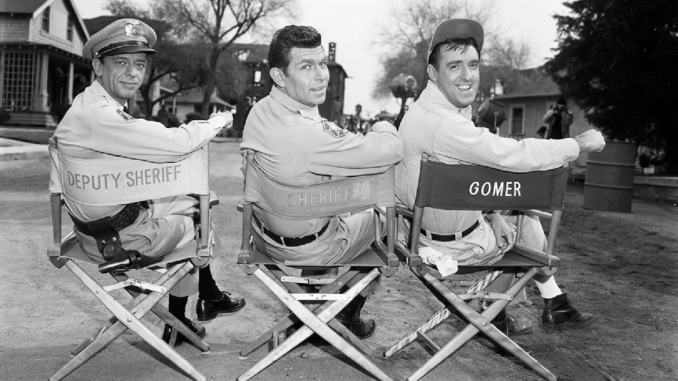
Television in the 1960s embraced outlandish concepts, from stranded castaways (Gilligan’s Island) to suburban witches (Bewitched) and neighborhood monsters (The Munsters). Yet amidst all the fantastical storytelling, The Andy Griffith Show stood out for its simplicity. It wasn’t about magic or mayhem but an idealized vision of small-town life and the innocence of bygone days.
Running from 1960 to 1968, the series followed Sheriff Andy Taylor (Andy Griffith), his young son Opie (Ron Howard), their kindhearted Aunt Bee (Frances Bavier), and Deputy Barney Fife (Don Knotts). Over time, Mayberry’s townsfolk became just as memorable, including Gomer Pyle (Jim Nabors), who eventually headlined his own spin-off. Even after The Andy Griffith Show‘s conclusion, the spirit of Mayberry lived on through Mayberry, R.F.D., a spin-off centered on new characters that aired for three more seasons.
Here’s a closer look at some of the secret sauce of the beloved series.
1. One good show deserves another
©CBS/courtesy MovieStillsDB.com
The show was first introduced through a 1960 episode of The Danny Thomas Show, where Danny Thomas is pulled over for speeding in Mayberry and gets a taste of the town’s unique charm. The success of that episode led to The Andy Griffith Show.
Andy Griffith was initially unsure about doing television. Performing in Destry Rides Again on stage, he met producer Sheldon Leonard, who pitched the idea. Though he didn’t love the concept, Griffith liked Leonard and agreed. His decision paid off, as he ultimately owned over half the show.
2. Evolving Andy Taylor
CBS Photo Archive/Getty Images
In the first season, Sheriff Taylor had a more comedic, country-bumpkin demeanor akin to Griffith’s stage performances. By season 2, he shifted to being the straight man in a town full of eccentric characters. Producer Aaron Ruben noted this change made the character more “Lincolnesque” and allowed the humor to shine through the supporting cast.
Griffith himself explained in The Andy Griffith Show Book: “Initially, I was supposed to tell funny stories about the town and be very Southern, very rural. But I realized I had to play it straighter.”
3. Ron Howard learned a lot
Bettmann Archives/Getty Images
At just six years old, Ron Howard (credited as Ronnie) couldn’t read when he started playing Opie, so cast members and his father helped him memorize lines. Looking back, Howard explained, “The set was warm and collaborative. Andy taught me how hard work and joy could go hand in hand, lessons I’ve carried into my directing career.”
4. That Bee could sting
Hulton Archive/Getty Images
Frances Bavier (Aunt Bee) reportedly struggled with the fast-paced demands of television. Her co-stars often felt they had to tread lightly around her and were taken to task for off-color humor. However, shortly before her death, Frances called Griffith to apologize for being difficult on set, a gesture he deeply appreciated.
4. There was no studio audience for a specific reason
Silver Screen Collection/Getty Images
Unlike many sitcoms of its time, The Andy Griffith Show avoided filming before a live studio audience. Griffith preferred single-camera shooting, explaining to author Richard Kelly: “With an audience, you need jokes every few minutes. Without one, you can focus on character comedy.”
5. The departure of Don Knotts
Hulton Archive/Getty Images
Originally planned as a five-season series, Don Knotts (Barney Fife) left after season 5 when Andy decided to extend the show. Don had already accepted a film deal from Universal, so the show explained his absence by having Barney join the Raleigh police force. Despite leaving as a regular, Don returned for five guest appearances and won five Emmy Awards for those performances.
6. Romance was a challenge
Smith Collection/Gado/Getty Images
Andy Taylor’s love life proved tricky for writers. The show initially paired him with Ellie Walker (Elinor Donahue), but the chemistry didn’t click. Elinor left after one season, later admitting she felt out of place. Griffith graciously told her years later, “We just didn’t know how to write for you.”
